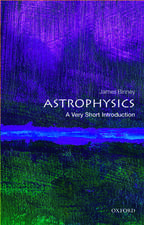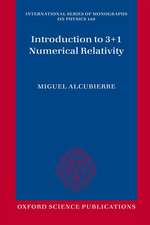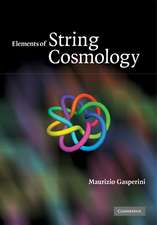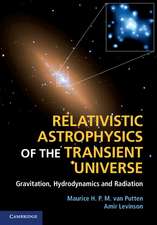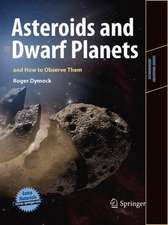Planets, Stars and Stellar Systems: Volume 4: Stellar Structure and Evolution
Terry D. Oswalt Editat de Martin A. Barstowen Limba Engleză Hardback – 22 ian 2013
All chapters of the handbook were written by practicing professionals. They include sufficient background material and references to the current literature to allow readers to learn enough about a specialty within astronomy, astrophysics and cosmology to get started on their own practical research projects. In the spirit of the series Stars and Stellar Systems published by Chicago University Press in the 1960s and 1970s, each chapter of Planets, Stars and Stellar Systems can stand on its own as a fundamental review of its respective sub-discipline, and each volume can be used as a textbook or recommended reference work for advanced undergraduate or postgraduate courses. Advanced students and professional astronomers in their roles as both lecturers and researchers will welcome Planets, Stars and Stellar Systems as a comprehensive and pedagogical reference work on astronomy, astrophysics and cosmology.
Preț: 3317.33 lei
Preț vechi: 4045.52 lei
-18% Nou
Puncte Express: 4976
Preț estimativ în valută:
634.78€ • 664.43$ • 528.33£
634.78€ • 664.43$ • 528.33£
Carte tipărită la comandă
Livrare economică 31 martie-14 aprilie
Preluare comenzi: 021 569.72.76
Specificații
ISBN-13: 9789400756144
ISBN-10: 9400756143
Pagini: 812
Ilustrații: XVI, 794 p. 315 illus., 143 illus. in color.
Dimensiuni: 155 x 235 x 49 mm
Greutate: 1.32 kg
Ediția:2013
Editura: SPRINGER NETHERLANDS
Colecția Springer
Locul publicării:Dordrecht, Netherlands
ISBN-10: 9400756143
Pagini: 812
Ilustrații: XVI, 794 p. 315 illus., 143 illus. in color.
Dimensiuni: 155 x 235 x 49 mm
Greutate: 1.32 kg
Ediția:2013
Editura: SPRINGER NETHERLANDS
Colecția Springer
Locul publicării:Dordrecht, Netherlands
Public țintă
Professional/practitionerCuprins
1. Stellar Structure. 2. Stellar Atmospheres. 3. The Sun as a Star. 4. Asteroseismology. 5. Star Formation. 6. Young Stellar Objects and Protostellar Disks. 7. Brown Dwarfs. 8. Evolution of Solar and Intermediate Mass Stars. 9. Evolution of High Mass Stars. 10. Stellar Activity. 11. White Dwarfs Stars. 12. Black Holes and Neutron Stars. 13. Binaries and Multiple Stellar Systems. 14. Supernovae and Gamma-Ray Bursts. 15. Stellar Winds.
Notă biografică
Dr. Terry D. Oswalt, an astronomer, is Head of the Department of Physics and Space Sciences and Associate Provost for Research at Florida Institute of Technology. He has also served the U.S. National Science Foundation as program officer for Stellar Astronomy and Astrophysics. He earned his Ph.D. in Astronomy at The Ohio State University specializing in photoelectric and spectroscopic studies of binary star systems, late stages of stellar evolution, minor planets, and comets.
Since coming to Florida Tech in 1982, Dr. Oswalt has taught astronomy and physics, while continuing his primary research interest in studies of collapsed stars called white dwarfs. Because such objects are very faint, this work often takes him to Kitt Peak National Observatory in Arizona, Cerro Tololo Inter-American Observatory in Chile, and Mauna Kea Observatory in Hawaii, where telescopes as large as 10-meters are available on a competitive basis to scientists.
Oswalt is the founding Chairman of the Southeast Association for Research in Astronomy, a consortium of 10 universities which operates an automated 1-meter telescope at Kitt Peak National Observatory near Tucson, Arizona. In 2007 SARA will assume operations of a similar telescope at Cerro Tololo Interamerican Observatory in Chile. Oswalt also has been director of the SARA summer internship program, which brings undergraduate students from around the U.S. to the SARA facility at Kitt Peak each summer to do research in astronomy. Dr. Oswalt has written over 100 scientific articles and edits the I.A.P.P.P. Communications, an international journal for advanced amateurs, students, teachers and professionals who collaborate on research and educational projects in astronomy. He is also the editor for a three-volume set of Springer books, "The Future of Small Telescopes in the New Millennium".
Dr. Martin Barstow received his undergraduate degree in physics from the University of York (UK) in 1979. From there, he became a member of the X-ray Astronomy group in the Department of Physics and Astronomy at the University of Leicester, receiving his PhD in 1983. His PhD work involved the development of a sounding rocket-borne extreme ultraviolet imaging telescope (jointly with MIT), which evolved into the United Kingdom’s EUV Wide Field Camera on board the ROSAT mission. Becoming ROSAT WFC detector scientist in 1984, he received a NASA Group Achievement award on its launch in 1990 and obtained a prestigious SERC (later PPARC) Advanced Fellowship for exploitation of the data in 1990.
Dr. Barstow was appointed to Lectureship in the Department of Physics & Astronomy in 1994, was promoted to Reader in 1998 and became Professor of Astrophysics and Space Science in 2003. He was head of the Physics and Astronomy department from 2005 to 2009 and is currently Pro-Vice Chancellor and founding Head of the College of Science and Engineering. His principal research interests are the study of hot white dwarf stars and the surrounding interstellar medium. In addition to ROSAT, he has been involved in many space missions during his career, including NASA’s Voyager probes, during their interplanetary cruises, the ESA EXOSAT mission, IUE, HST and FUSE. Recently he was a member of the Space Telescope Users’ Committee helping to develop the plans for the final servicing mission, which took take place in May 2009. He is continues to fly sounding rockets, be involved in research with Hubble as well as leading the Leicester contribution to the ESA Gaia mission.
During the past few years, Dr. Barstow has played an increasingly important role in scientific funding and advisory structures, become a member of Science and Technology Facilities Council in 2009. He has also recently been appointed to membership of the ESA Astronomy Working Group and Space Programme Advisory Committee of the United Kingdom Space Agency.
Since coming to Florida Tech in 1982, Dr. Oswalt has taught astronomy and physics, while continuing his primary research interest in studies of collapsed stars called white dwarfs. Because such objects are very faint, this work often takes him to Kitt Peak National Observatory in Arizona, Cerro Tololo Inter-American Observatory in Chile, and Mauna Kea Observatory in Hawaii, where telescopes as large as 10-meters are available on a competitive basis to scientists.
Oswalt is the founding Chairman of the Southeast Association for Research in Astronomy, a consortium of 10 universities which operates an automated 1-meter telescope at Kitt Peak National Observatory near Tucson, Arizona. In 2007 SARA will assume operations of a similar telescope at Cerro Tololo Interamerican Observatory in Chile. Oswalt also has been director of the SARA summer internship program, which brings undergraduate students from around the U.S. to the SARA facility at Kitt Peak each summer to do research in astronomy. Dr. Oswalt has written over 100 scientific articles and edits the I.A.P.P.P. Communications, an international journal for advanced amateurs, students, teachers and professionals who collaborate on research and educational projects in astronomy. He is also the editor for a three-volume set of Springer books, "The Future of Small Telescopes in the New Millennium".
Dr. Martin Barstow received his undergraduate degree in physics from the University of York (UK) in 1979. From there, he became a member of the X-ray Astronomy group in the Department of Physics and Astronomy at the University of Leicester, receiving his PhD in 1983. His PhD work involved the development of a sounding rocket-borne extreme ultraviolet imaging telescope (jointly with MIT), which evolved into the United Kingdom’s EUV Wide Field Camera on board the ROSAT mission. Becoming ROSAT WFC detector scientist in 1984, he received a NASA Group Achievement award on its launch in 1990 and obtained a prestigious SERC (later PPARC) Advanced Fellowship for exploitation of the data in 1990.
Dr. Barstow was appointed to Lectureship in the Department of Physics & Astronomy in 1994, was promoted to Reader in 1998 and became Professor of Astrophysics and Space Science in 2003. He was head of the Physics and Astronomy department from 2005 to 2009 and is currently Pro-Vice Chancellor and founding Head of the College of Science and Engineering. His principal research interests are the study of hot white dwarf stars and the surrounding interstellar medium. In addition to ROSAT, he has been involved in many space missions during his career, including NASA’s Voyager probes, during their interplanetary cruises, the ESA EXOSAT mission, IUE, HST and FUSE. Recently he was a member of the Space Telescope Users’ Committee helping to develop the plans for the final servicing mission, which took take place in May 2009. He is continues to fly sounding rockets, be involved in research with Hubble as well as leading the Leicester contribution to the ESA Gaia mission.
During the past few years, Dr. Barstow has played an increasingly important role in scientific funding and advisory structures, become a member of Science and Technology Facilities Council in 2009. He has also recently been appointed to membership of the ESA Astronomy Working Group and Space Programme Advisory Committee of the United Kingdom Space Agency.
Caracteristici
Presents comprehensive coverage of state-of-the-art 21st century Stellar Structure and Evolution research Provides the essential background and directs readers to other seminal literature on the topics discussed Well-suited for lecturers and students as material for advanced courses in astronomy Volume 4 of a six-volume compendium of modern astronomical research covering subjects of key interest to the main fields of contemporary astronomy and astrophysical cosmology


